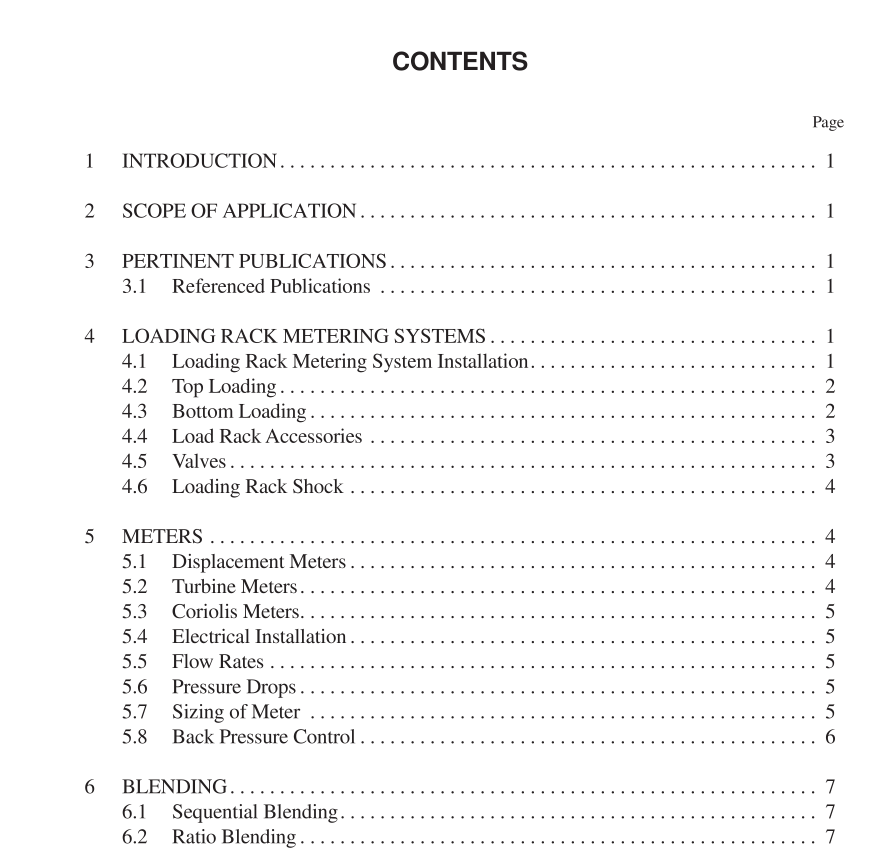API MPMS 6.2 pdf download

API MPMS 6.2 pdf download.Manual of Petroleum Measurement Standards Chapter 6—Metering Assemblies
4.2 TOP LOADING
Since State and Federal regulations govern the release of hydrocarbon emissions to the atmosphere, some forms of top loading may not be acceptable. Top loading (see Figure 1) requires the use of an overhead- loading arm to reach the loading dome hatches on the trucks. Loading arms should be designed to reach all domes on a sin- gle-bottom truck to avoid moving the truck. They should be equipped with an extended drop tube and either a deflector end or a 45º cut C tube end that will reach to the bottom of the truck and provide submerged filling. The loading arm should be in the same state of fill—either void or full—at the begin- ning and end of the loading operation to ensure measurement consistency. Top loading arms designed to be completely empty when not in use should be equipped with a manual or automatic vacuum breaker located at the high point in the piping and downstream of the loading valve. This provision allows the arm and drop tube to drain after the loading valve is closed. Top loading arms should be designed to swing up to avoid interfering with trucks entering the loading area and should be counterbalanced by a spring or weight to enable easy posi- tioning. When overhead clearance is insufficient for swinging the loading arm, the loading arm must be moved horizontally and the drop tube must be attached and detached at each load- ing dome on the truck. Meters for top loading racks can be located on the loading platform or near the ground. When the meter is located below the platform, the meter register shall be located to facilitate the reading of quantities by the truck loader, who shall be positioned to observe the filling of the compartment. A preset device, either local or remote, may be installed in any loading system to expedite loading operations.
4.4 LOAD RACK ACCESSORIES
4.4.1 Strainers A strainer should be installed upstream of the meter, per manufacturer’s recommendations, to trap solid particles that could damage the meter. The strainer shall be checked and cleaned periodically, since an accumulation of solid material in the strainer can restrict flow, creating the potential for prod- uct vaporization just upstream of the meter, and could cause the flow rate to differ from the meter-proving flow rate. 4.4.2 Air Eliminators Air eliminators are required in systems where air can be induced into the system. The air eliminator is located upstream of the meter, and its purpose is to dispose of any air in the delivery line before it passes through the meter. If a sys- tem is designed so that significant amounts of air, vapor, or both cannot be introduced, an air eliminator is not required. 4.4.3 Vapor Control Regardless of the type of loading that is used—either bot- tom loading or top loading—some vapor will be produced in the truck compartment. The turbulence of the incoming prod- uct and the rising liquid level will cause air and vapor to be dispersed either out the top of the truck compartment to the atmosphere or to a vapor-processing system. If the system is equipped with a vapor control system, a check valve shall be installed in the vapor line as mandated by EPA regulations.
4.5 VALVES
4.5.1 Thermal Relief Valves Thermal relief valves are required to prevent over-pressur- ization of the metering system. Any section of the tank-to-loading-rack supply piping that can be isolated by the closing of control valves, block valves, check valves, etc. shall be protected by thermal relief. The integrity of these valves shall be verified periodically because of their potential to impact measurement. Thermal relief lines should be located to minimize the potential for product bypass around the meter, which can affect measurement accuracy. Installation upstream of the main product meter is acceptable provided the product flow control valve will relieve internally when downstream piping experiences excessive pressure.









